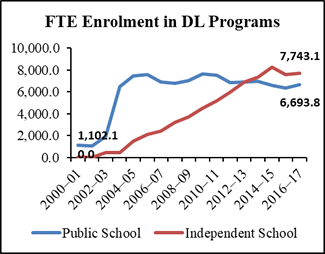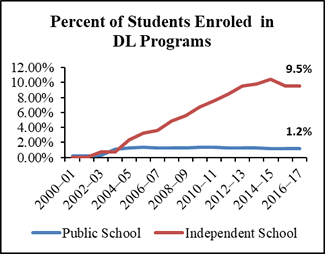
Figure 1: FTE enrolment in DL programs in public and independent schools. Source: Ministry of Education, Student Statistics, 2000–01 through 2016–17.1
More students in BC Distributed Learning (DL) programs are registered with independent schools than public schools. About 10% of all independent school students funded by the Ministry of Education are in DL programs, with most of them in three DL schools. A significant portion of the total increase in independent school students in the last 15 years has been in DL enrolment.
Face-to-face independent schools receive public funding based on 50% or 35% of the per-student funding for the public school district in which the school is located. However, independent DL schools receive 63% or 44.1% of the provincial funding for students in public DL schools. When the province started fundingpublic DL students at a lower rate than face-to-face (F2F) students, the independent schools lobbied government and got an increase so that DL students in their programs are funded at about the same dollar amount as those in independent school F2F programs.
Independent schools are allowed to pay up to $350 a year, for ongoing Internet costs to their students' families.
However, audit criteria for the public DL schools allow only a connection fee to be paid, excluding any ongoing costs of monthly costs for the Internet.
Although the Ministry claims that DL schools are not allowed to offer “incentives” to have students choose their program, Internet costs have given independent schools an advantage. They are allowed to pay up to $350 a year, for ongoing Internet costs to their students’ families. However, audit criteria for the public DL schools allow only a connection fee to be paid, excluding any ongoing costs of monthly costs for the Internet.
The largest of the independent DL schools is run by Heritage Christian Online School, but they call it “BC Online School.” It is aggressively marketed online—when one does a Google search for BC online school, it comes up first and displays that name with a background of a BC flag. Only in tiny print does it say “A Division of Heritage Christian Online School.” Heritage Christian also pays to have the highest placement on Google when a searcher looks for an online school.

Figure 2: percent of students enrolled in DL programs in public and independent schools.
Source: Ministry of Education, Student Statistics, 2000–01 through 2016–17.2
A difference between how special needs services are provided in public and independent DL schools
Many parents of students with special needs are choosing independent school Distributed Learning options for their child. This is happening because Ministry of Education financing rules provide full funding for special needs and allow services in independent school programs to be directed to a specific child, unlike in the public schools.
Parents are making the difficult choice to remove their child from the public school system, and redirect this individualized funding because they felt their children were being seriously underserved with in-classroom and other individualized supports in the public schools. Multiple children sharing an education assistant, lack of resource teachers because districts aren’t hiring sufficient numbers of non-enrolling teachers, too few specialist staff for the large number of students with high needs.
Public DL students are in competition for the already inadequate special needs services that are split between both face-to-face and DL students.
Students sitting in a classroom are more likely to get services than those working at home, on their computers.
Students identified with low incidence special needs are funded with grants over the per-student amounts for all students. These special grants are $9,800 for serious mental illness or intensive behavior interventions, $19,100 for visual impairment, deaf and hard of hearing and autism spectrum disorder, and $38,800 for physically dependent, and deafblind students. Independent schools receive the full amount of these grants for students with these identified special needs, even though the per-student government grants for students are otherwise 50% or 35% of the amount for public schools.
Public school districts receive special needs funding based on the number of identified students in the funding categories. The district uses the funding for services to the students with special needs—but an amount that goes to the district is not necessarily directed to the particular student whose need is the source of funds.
Public school DL teachers in a BCTF survey were concerned that their DL students were not receiving the amount of special needs services that are required. DL students are in competition for the already inadequate special needs services that are split between both F2F and DL students. Students sitting in a classroom are more likely to get services than those working at home, on their computers.
The funding of independent schools allows for them to hire third-party, private services with the use of funding for special needs. The parent can have a say in who is contracted by the school to provide service to the individual DL student in their home. The independent school is allowed to pay for a private assessment of the child to establish their special needs—which the parent would have to pay for if the child was in the public school and was well down the waiting list for an assessment.
The funding of independent schools allows for them to hire third-party, private services with the use of funding for special needs.
The independent school is allowed to pay for a private assessment of the child to establish their special needs—which the parent would have to pay for if the child was in the public school and was well down the waiting list for an assessment.
These differences serve as an encouragement for parents of children with identified special needs to enroll their child in an independent school Distributed Learning program. The impact is that special education funding produces nearly half of the DL funding received by independent schools.
Between 2010–11 and 2015–16, grants for DL special education programs in independent schools steadily increased by a total of $17,843,200 (and increase of 236.9%). Furthermore, while in 2010–11 the grant for special education made up only 24.4% of the total grant received by independent schools for DL, by 2015–16 the special education grant made up 43.0% of DL grants.
One can understand why parents would look for the most service possible for their child with special needs and seek a program that is directed to their child. The high demand in the public schools for support for special needs is not met by the current levels of funding and the sharing of those resources may produce less support for a particular student.
Supporting students with special needs in public F2F and DL schools requires more funding for the wide range of special needs. While low incidence, high cost students bring supplementary funding to districts, that is not the case for students in the high incidence special need categories. More services must be available in the public schools—F2F and DL—to ensure that parents don’t have to abandon the public schools and choose independent schools to get the needed services for their child.
It is ironic that at a time when inclusion of students is the mandate of public education, funding policies lead students to be educated alone, outside of an educational setting with other students.
Current government funding policies encourage parents to choose independent DL schools over public schools. Policies that provide Internet cost incentives, higher grants for independent DL schools and that push children with special needs out of the public schools, should be changed.